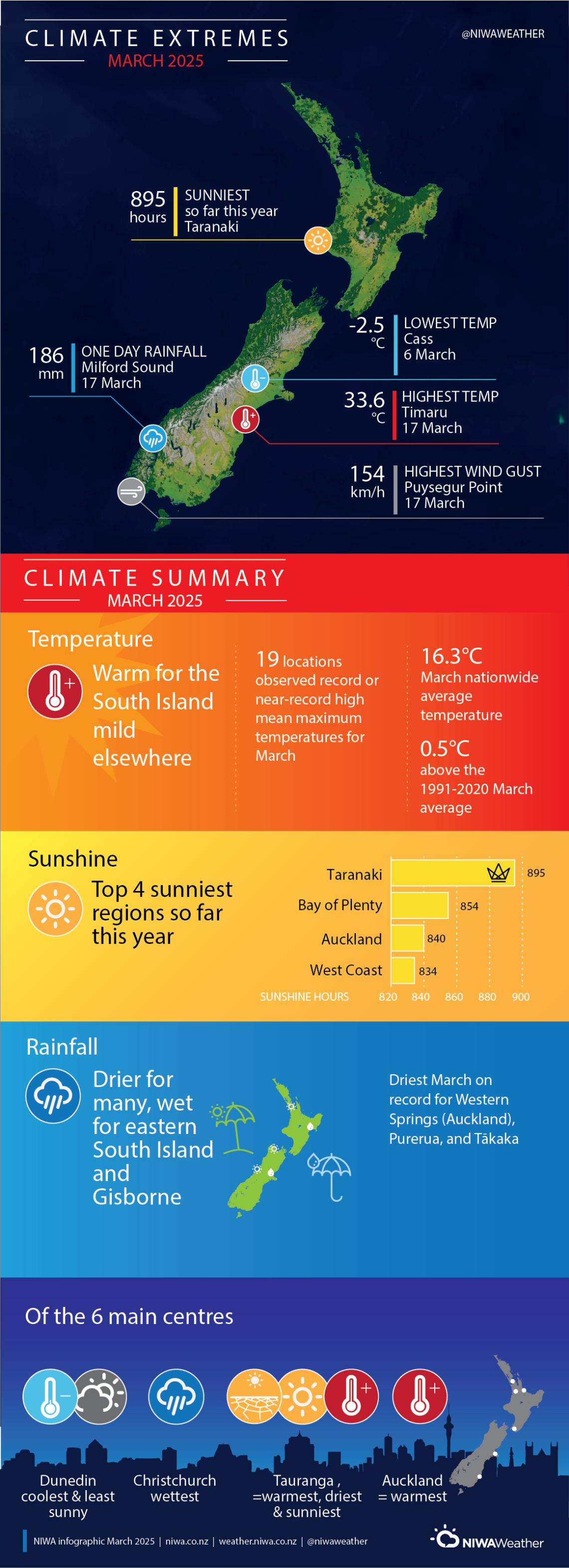Overview
| Rainfall | Below normal rainfall (50-79% of normal) or well below normal rainfall (<50% of normal) was observed across much of the North Island, and northern, western and inland parts of the South Island. Above normal rainfall (120-149% of normal) or well above normal rainfall (>149% of normal) was observed in Gisborne, northern Hawke’s Bay, and the eastern South Island. |
| Temperature | Temperatures were above average (0.51-1.20°C above average) or well above average (>1.20°C above average) for most of the South Island, as well as parts of Wellington, Taranaki, northern Hawke’s Bay, Bay of Plenty, and Northland. Temperatures were typically near average (±0.50°C of average) for the remainder of the country. |
| Soil Moisture | At the end of March, soil moisture levels were well below normal for most of the North Island, and northwestern parts of the South Island. Soil moisture levels were above normal about Banks Peninsula, Selwyn District, and southern and northern parts of Hawke’s Bay. Elsewhere, soil moisture levels were mostly near normal. |
March was characterised by higher-than-normal mean sea level pressure (MSLP) over and west of Aotearoa New Zealand. This was associated with more southwesterly airflows than normal over the upper North Island, with long spells of settled weather for many parts of the country. March rainfall was below normal (50-79% of normal) or well below normal rainfall (<50% of normal) in parts of every region, except for Gisborne. It was particularly dry in parts of eastern Northland, Auckland, Bay of Plenty, and northern Tasman where less than 20% of normal March rainfall was recorded. In contrast, rainfall was above normal (120-149% of normal) or well above normal (>149% of normal) across eastern parts of the South Island from Cape Campbell to Dunedin, as well as in Gisborne.
March temperatures were above average (0.51-1.20°C above average) or well above average (>1.20°C above average) for most of the South Island, parts of Wellington, Taranaki, northern Hawke’s Bay, Bay of Plenty, and southern and northwestern parts of Northland. Temperatures were typically near average (±0.50°C of average) for remaining parts of the country, including about Dunedin. No locations observed below average temperatures (0.51-1.20°C below average). The nationwide average temperature in March 2025 was 16.3°C. This was 0.5°C above the 1991-2020 March average from NIWA’s seven station temperature series which begins in 1909.
Further highlights:
- The highest temperature was 33.6°C, observed at Timaru on 17 March.
- The lowest temperature was -2.5°C, observed at Cass (inland Canterbury) on 6 March.
- The highest 1-day rainfall was 186 mm, recorded at Milford Sound on 17 March.
- The highest wind gust was 154 km/h, observed at Puysegur Point on 17 March.
- Of the six main centres in March 2025, Auckland and Tauranga were the equal-warmest, Tauranga was the driest and sunniest, Christchurch was the wettest, and Dunedin was the coolest and least sunny.
- The sunniest four locations so far in 2025 are Taranaki (895 hours), Bay of Plenty (854 hours), Auckland (840 hours), and West Coast (834 hours).
Download
Download the full Climate summary for March 2025


